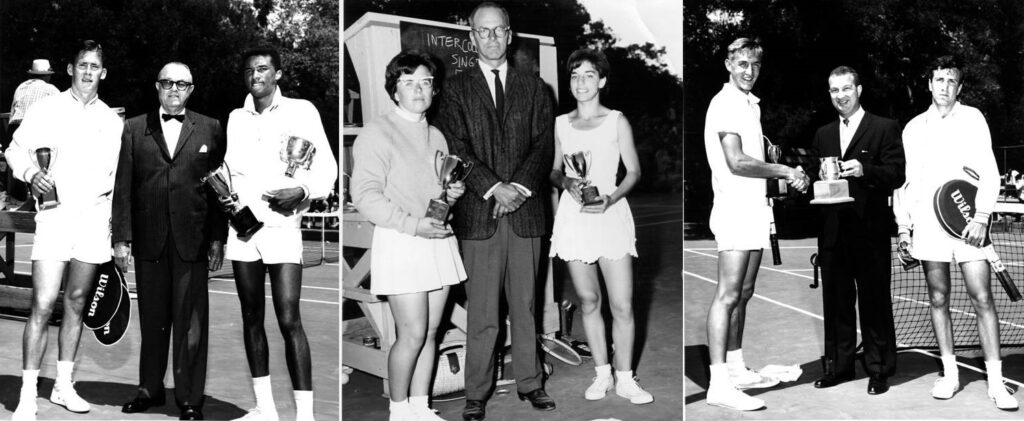
Club formed
0

volunteers
0
+

players
0
+

tennis courts
0




The history of The Ojai really dates back to 1887 when Sherman Day Thacher came to Ojai to become a farmer and grow citrus. After building his stone house on 160 acres of land in the East End of the valley, he soon learned that he would require some financial assistance to survive, and so started tutoring students on the ranch, then called Casa de Piedra.
Brother William Thacher, the New England and intercollegiate tennis doubles champion while a junior at Yale University in 1886, came to the valley in 1890 for a family wedding, and stayed on to help with the school. In 1892, the first tennis court in the Valley was built on the school grounds. The first tennis tournament in Ojai was held on that court in 1893.
As part of his involvement with the Ojai Valley and the town, then Nordhoff, Sherman Thacher helped found the Ojai Athletic Club in 1894; and the next year, William Thacher decided to form a club devoted to tennis, and so the Ojai Valley Tennis Club was born. The club quickly began to sponsor competition, and in 1896, the Ojai Valley Tennis Club absorbed the Athletic Club with William Thacher as President.
Competition in earnest started in 1896 with a challenge to the Ventura Tennis Club, a popular valley wide event. The following year, the Ojai Tennis Club sponsored inter-county competition, teaming with Ventura to challenge Santa Barbara; and later combined forces with Ventura and Santa Barbara to challenge Los Angeles and Pasadena.
In the fall of 1897, William Thacher announced a “State Tournament” which was to take place in April, 1898, and pit the best players of northern and southern California in a round robin match. The entire town was involved in this tournament, which featured decorations and social events, and the local railroad had special passenger fares and extra trains for the occasion.
In 1899, the tournament adopted the single elimination format and offered multiple categories of play, adding interscholastic singles and doubles matches to the growing tournament. Attendance was almost 700 over the weekend of the finals, and the town held a reception and dance for the players. Many consider this the first Ojai.
The turn of the century brought other developments to the tournament. Tea service was introduced, and the clubhouse was built that year, remaining on site until 1966. The tournament lasted 3 days, offered expanded categories, and had entry fees of $.50. Players traveling to the Valley stayed with local residents, a tradition which continues today.
In 1905, there were over 100 competitors in the Tournament, and in 1907, girls’ interscholastic competition was introduced. By 1912, there were 272 entrants in twelve events, making it the largest tournament of its kind in the United States.
In 1916, women’s’ intercollegiate competition was added, and the town’s named was changed to Ojai the following year. In spite of the looming war, the competition was held, with the proceeds of the 22nd Ojai turned over to the Red Cross. That same year, a major fire burned much of the Ojai Valley, causing the tournament to be held in Los Angeles in 1918, the only year it was held elsewhere.
In 1924, an outbreak of foot and mouth disease broke out among California livestock, and travel was restricted in much of the state. Accordingly, it was decided at the last minute to cancel the tournament – the 29th Ojai was not to be.

The tournament returned in 1925, and grew and prospered over the following years. Complimentary orange juice, a product of the Valley, was first offered to players and spectators in the early 1930s, which continues today. As the tournament grew, its reputation spread, drawing players from all over the West.
In 1942, with World War II in full fury, the tournament was cancelled, not to return until 1947. Once re-established, the tournament re-staked its claim to the last full weekend in April, offering its competition on the town’s public courts and whatever other courts could be secured in the Valley and northern Ventura County. Last year, over 105 courts were volunteered to be used by competitors.
In 1951, team competition was emphasized with trophies to be awarded in the collegiate division. At the same time, with the advent of professional tennis, many of the name players stopped competing in Ojai. Then, in 1954, the colleges that make up the current PAC 12 split off from the other four year colleges to form their own athletic conference. These collegiate events gained in stature, and now the annual PAC 12 men’s and women’s championships, doubles and singles, are held in Ojai, and highlight the five-day competition.
Many of the greats of tennis have played in Ojai, including Bill Tilden, Tony Trabert, Bobby Riggs, Jack Kramer, Arthur Ashe, Billie Jean King, Pancho Gonzales, Alex Olmedo, Stan Smith, Jimmy Connors, Tracy Austin, Michael Chang, Lindsay Davenport, Pete Sampras and the Bryan twins. The “Wall of Fame” at the grandstand in Libbey Park names 89 players who competed at Ojai, and won one or more of the major championships which make up the tennis “Grand Slam.”
And so, after all these years, much has changed, and yet much remains the same. Thousands of spectators fill the Valley for five days to watch the finest in amateur tennis, enjoy fresh orange juice in the mornings, and tea and cookies in the afternoon, all provided by a tennis club that has no courts of its own and no paid employees. On behalf of the more than 600 volunteers that make this tournament possible, we welcome you to The Ojai!